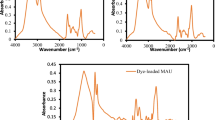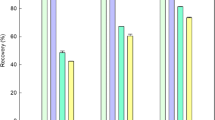Abstract
The metal-binding ability of Aspergillus niger mycelial waste was improved by chemical modification. The latter was performed by introducing additional carboxy groups using oxidation methods or the introduction of the ethyldiamino group first by chlorination of A. niger using mesyl chloride and subsequent reaction of the product with ethylene diamine. Metal binding abilities of the products for Cd2+, Co2+, Ni2+ and Zn2+ were determined according to the Langmuir model, whereby pK *D -values of 3.88 up to 5.02 were revealed. Maximum capacities for the metals were found to be in the range 172 to 1064 mmol/kg.
Similar content being viewed by others
References
Barrow GM. 1984 Physikalische Chemie, Gesamtausgabe 6. Auflage, Braunschweig: Vieweg.
Dorfner K. 1970 Ionenaustauscher, 3. Auflage, Berlin: Verlag de Gruyter.
Fa. Merck 1964 Die Untersuchung von Wasser — Eine Auswahl chemischer Methoden für die Praxis, Darmstadt: Fa. Merck: 32-34.
Floor M, Hofsteede LPM, Groenland WPT, Verhaar LAT, Kieboom APG, van Bekkum H. 1989 Preparation and calcium complexation of oxidized polysaccharides. II.: Hydrogen peroxide as co-reactant in the chlorite oxidation of dialdehyde glucans. Rec Trav Chim Pays-Bas 108, 384-392.
Gadd GM. 1990 Fungi and yeasts for metal accumulation. In: Ehrlich HL, Brierley CL, eds. Microbial Mineral Recovery New York: Macmillan, 249-275.
Gauer J. 1996 Synthese kationenaktiver Derivate auf Holzbasis und Untersuchungen über ihren Einsatz zur Entfernung von Schwermetallen aus wäßrigen Lösungen. Dissertation, Universität des Saarlandes, Saarbrücken.
Gemeinsames Ministerialblatt I 1989 Anhang 40 zur allgemeinen Rahmen-und Verwaltungsvorschrift über Mindestanforderungen für das Einleiten von Abwasser in Gewässer, Bonn: 523-524.
Hartinger L. 1991 Handbuch der Abwasser und Recyclingtechnik für die metallverarbeitende Industrie. 2. Auflage, München: Carl Hanser Verlag.
Houben-Weyl 1953 Methoden der organischen Chemie, Band 2: Analytische Methoden, Stuttgart: Thieme Verlag.
Huheey, J. E. 1988 Anorganische Chemie, Prinzipien von Struktur und Reaktivität, 3. Auflage, Berlin: Walter de Gruyter.
Johnston, I. R. 1965 The composition of the cell wall of Aspergillus niger, Biochem J 96, 651-658.
Luef E, Prey T, Kubicek CP. 1991 Biosorption of zinc by fungal mycelial wastes, Appl Microbiol Biotechnol 34, 688-692.
Matsumura S, Yokochi E, Winursito I, Toshima, K. 1997 Preparation of novel biodegradable polyampholyte: Partially dicarboxylated chitosan. Chem Lett 3, 215-216.
Mocanu G, Constantin M, Carpov, A. 1996 Chemical reactions on polysaccharides, 5. Reaction of mesylchloride with pullulan. Angew Makromol Chem 214, 1-10.
Muzzarelli RAA, Tanfani F. 1982 The chelating ability of chitinous materials from Aspergillus niger, Streptomyces, Mucor rouxii, Phycomyces blakesleeanus and Choanephora cucurbitarum. In: Hirano S, Tokura S, eds. Chitin and Chitosan, Proceedings of the Second International Conference on Chitin and Chitosan, July 12–14, Sapporo, Japan, 183-186.
Nakamura S, Amano M, Saegusa Y, Sato T. 1992 Preparation of aminoalkyl celluloses and their adsorption and desorption of heavy metals. J Appl Polym Sci 45, 265-271.
Naseem Akthar M, Sivarama Sastry K, Maruhti Mohan P. 1996 Mechanism of metal ion biosorption by fungal biomass. BioMetals 9, 21-28.
Polyakov AI, Rogovin ZA. 1963 Synthesis of new cellulose derivatives-XXII. Synthesis of chlorocellulose and its conversion products. Preparation of amino-and nitrilocellulose. Vysokomol. Soyed. 5:No 1 11-17; Polym Sci USSR 5, 610–618.
Schuhmacher C. 1995 Entfernung von Schwermetallen aus wäßrigen Medien durch Retention an chemisch modifizierter chitinhaltiger Abfallbiomasse. Dissertation, Universität des Saarlandes.
Tashiro T, Shimura Y. 1982 Removal of mercuric ions by systems based on cellulose derivatives. J Appl Polym Sci 27, 747-756.
Volesky B. 1987 Biosorbents for metal recovery. Trends Biotechnol 5, 96-101.
Author information
Authors and Affiliations
Rights and permissions
About this article
Cite this article
Krämer, M., Meisch, HU. New metal-binding ethyldiamino- and dicarboxy-products from Aspergillus niger industrial wastes. Biometals 12, 241–246 (1999). https://doi.org/10.1023/A:1009286132147
Issue Date:
DOI: https://doi.org/10.1023/A:1009286132147




